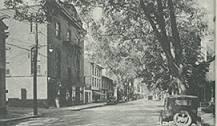
Castleton-on-Hudson has a rich history, full of energy, adaptability, and beauty. The nearby Hudson river linked the village to other communities along the bustling river corridor. Many generations have recognized the importance of the river, from the - Indians who chose the area's hills as vantage points and meeting places, to the Dutch farmers who hoped to establish a large scale farming economy, and to enterprising shopkeepers of the mid nineteenth century. The strategic location made the area a crossroads, always linked to the larger world and its society and culture.
The river offered beautiful vistas as well, drawing many to build their suburban homes here in the late 1800's. From the top of the hills, one could view miles of the river, and one could travel easily to communities north and south. This would bring to the area many of the influences of the larger urban areas down the river, and it brought many travelers and new residents.
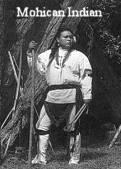
As far as we know, the first inhabitants to live in the Castleton-on-Hudson area were the Mohican Indians, who, according to their own traditions, long ago came from the west. They were related to other Algonquian groups on the Hudson River and in New England. They were peaceful and lived off the land by hunting, fishing and gathering wild foods. They also were farmers who raised ample supplies of maize (corn), squash and beans, much of which they dried and stored for winter.
When Henry Hudson, sailing for the Dutch, arrived on the northern half of the river which now bears his name, he found the Mohicans occupying both sides of the river. They welcomed the explorers and Hudson called them a "very good people." At an Indian village, possibly located at Castleton-on-Hudson, he met many people who lived in a longhouse; they had large supplies of maize on hand. Although afterward dominated by the Mohawks as a result of war and the fur trade, the Mohicans nonetheless were important as owners of the land and kept their villages near the Hudson. While some moved east to the Housatonic valley in the eighteenth century, a few remained along the Hudson River until the early nineteenth century. Indian burial grounds were found around Castleton over the years. The old tradition of a Mohican village or "castle" on the hill gave Castleton-on-Hudson the first part of its name.
In the 1600's, the area became part of Rensselaerswyck, a colony owned by the Van Rensselaers, who bought land from the Mohicans. New Netherland became New York in 1664, but the area retained its Dutch flavor as the site of future Castleton-on-Hudson was occupied by settlers under Van Rensselaer leases. The large holdings of one early farmer, Johannes Van Buren, included a ship's dock on the river near his house, a house which still stands in Castleton-on-Hudson. After his death, his heirs late in the 1700's hired a surveyor to lay out numbered lots for a community north and east of the landing. These lot numbers are still used.
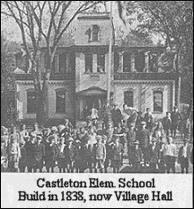
The year 1800 found only about half a dozen houses clustered at the south end of what is now Main Street, and a tavern about half a mile to the north. Trade on the river was growing, however, as roads were improved to the farms and hamlets of the interior. Steamboats began to be built after 1808, when Fulton's folly was first build. It is said that Fulton's steamboat got stuck on a sandbar just north of Castleton-on-Hudson in 1808.
In 1802 there came a man to the village who had vision - James L. Hogeboom. He was not a farmer, but a merchant. He built a store near the site of the landing and encouraged farmers to ship their produce through his office. He brought goods from New York and elsewhere to trade for this produce and soon had a thriving business. Others came to share in this profitable business and Castleton-on-Hudson became a trading center. Pork, vegetables, and grain were bought from farmers and sent to New York City on barges where they were traded for materials that the farmers could use. An ancient mill located south of the village was used to saw logs and grind grist. The first revolving rake was constructed at this mill.
Brickyards furnished another source of trade. Probably the largest was located where later the A. C. Cheney Piano Action Company was erected, and where now the Castleton Fire Company building is located. There were other brickyards along Green Avenue and Seaman Avenue.
During this period the village grew from half a dozen families to about 25, and in 1827 there were 100 people living in the village. In 1815 Catherine Van Buren gave the village a lot for school purposes, and in 1820 the first school was built at the location where the present Village Hall is located. A letter from the National Archives tells us that a Post Office was established in Castleton-on-Hudson on April 8, 1815.
The incorporation of the village in 1827 signalled that a group of entrepreneurs were expecting Castleton-on-Hudson to grow and indeed business expanded along Main Street. In 1829 the first doctor, Dr. James S. Hogeboom, established a practice in Castleton-on-Hudson. In 1838 the first church, a Methodist church, was erected in Castleton-on-Hudson. Also in 1838, a new school house was erected on the site of the first school, which eventually became the current Village Hall in 1868. In the 1850's a number of stores opened, and the river freighting business attracted more new residents. In February, 1853, a Reformed Church was dedicated.
Business was now built on the sale of brick, farm products, and hollow ware. Much of the surrounding country was under the plow, the soil was rich and the crops abundant. During the Civil War, there was a market in New York City for all the farmer could produce. Hay and fruit soon became valuable commodities.
In 1848 a railroad started from New York City which reached Castleton-on-Hudson in 1851. In the beginning the railroad did not affect transportation of freight by boat, because river transportation was cheaper and heavy freight did not need the speed of the railroad.
In 1856 Charles Benthuysen came to Castleton-on-Hudson and started a paper mill on the grounds of what later became the Fort Orange Paper Company. By modern standards his paper production was small, but it was the beginning of an industry which in years to come would be the mainstay of the economy of the village.
During this period building was started on the hills of Castleton-on-Hudson. Seaman Avenue was then known as North Hill. Main Street as River Street and Scott Avenue was the Middle Hill. Houses were built on Stimpson Avenue, Chestnut Street, Willow Street, and the upper end of Green Avenue. There were no houses on upper Scott Avenue or on Campbell Avenue.
In the mid 1800's a well known architect, Frank Jesup Scott, contributed to the architectural and landscape beauty in Castleton-on-Hudson. He designed the Scott mansion for his father Jesup Scott, which is still an important example of the lovely homes that were built to take advantage of the broad vistas on the Castleton-on-Hudson hills. Scott also designed the Village Hall which originally housed the public school. In addition, because Castleton-on-Hudson was built on a hill overlooking the river with a number of brooks and creeks flowing over the land toward the river, he recommended a drainage system using clay pipes, dug at about three feet below the surface, to carry off the excess water. Several homes built along Main Street have these clay pipes, installed probably in the mid 1800's, still in use today. The systems also included brick cisterns, some of which are also found to be of use today

Many things happened in this period which were to leave their mark on Castleton-on-Hudson for years to come.
From 1870 to 1920 the ice business thrived in Castleton-on-Hudson. Each year, during the months of January and February, men from the village and from farms for a distance of ten miles from the river, together with traveling laborers, came to the river to cut ice. They worked from daylight to dark cutting the ice and pushing the cakes to the ice house where they traveled up an elevator into a large room where men packed the cakes of ice in sawdust or hay. The pay was good for those days and many a man went home with more money than he made at any other time of year. A small crew was kept busy all summer taking the ice from the ice houses and placing it on barges where it was taken to New York City and sold. This business failed with the coming of artificial ice and refrigerators. Today not a single ice house remains. Near Castleton-on-Hudson they have burned or fallen down and the lumber has been taken away.
What did the Village of Castleton-on-Hudson look like in 1870? The Gazetteer and Business Directory of 1870 lists Castleton-on-Hudson as having two churches (the Methodist and the Reformed), one hotel, six stores, a stove and tin shop, a jewelry shop, a lumber yard, five brick yards, and a population of about 600 people. Five barges ran daily between Castleto-on-Hudsonn and New York City, two for produce and three for brick.
In 1871 much of the business section of the village was destroyed by a disastrous fire. The records show that there were also large fires in the village in 1889, 1897, and 1898. The Frank P. Harder Engine was organized in 1871 and was composed of 60 men for the engine company and 20 men for the hose company. In those early days there was no village water supply and the fire engines had to pump water from the river, thus affording no fire protection for the buildings on the hills of Castleton-on-Hudson.
In 1874, a screw factory was incorporated to manufacture metal screws, bolts, rivets, nuts, and washers. The factory was built on a tract of land near the intersection of Green Avenue and First Street. The business soon failed, however, and the imposing building remained empty for 25 years until it became the main building of the A. C. Cheney Piano Action Company in 1899. That company prospered for many years until about 1930 when it had ceased to exist.
In 1881 Benthuysen sold his paper mill to Woolworth and Graham who called it the Fort Orange Paper Company. They increased production to about 16 tons per day. The products of the mill were post cards, bank books, colored paper, pads, and tablets. In 1895 about 200 men were employed.
The telephone came to Castleton-on-Hudson in 1897. The Community Water System Supply House of Syracuse, N.Y., built the municipal water system in 1897 and water was furnished to users on a rental basis. The Water Supply System was purchased by the village in 1913 for $50,000.
The increase in the population of the village up to this period had been either natural or the result of people coming from other sections of the country, with the exception of a few Irish immigrants from across the sea. In 1875, however, a considerable German immigration resulted from Germans seeking to escape military service in their native land. Ten years later a new group of Dutch settled here.
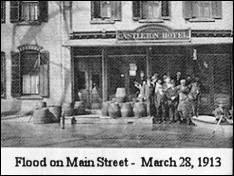
About 1903 John Shayne came to Castleton-on-Hudson and installed a small direct current dynamo and engine and began to supply some of the homes and business places with electrical power. Eventually the Schodack Light and Power Company was formed, and electricity was made available to the entire village. Later the Schodack Light and Power Company was purchased by the New York Power and Light Company.
During 1907 the Phoenix Paper Company, a folding carton paper plant, moved its equipment from Brooklyn to the property of the Fort Orange Paper Company, thereby starting in Castleton-on-Hudson the process of folding paper cartons from board produced by the Fort Orange Paper Company. In 1913 the Fort Orange Paper Company purchased the Phoenix Paper Company, and founded the first company to manufacture board and fabricated cartons under one roof. The Fort Orange Paper Company became an outstanding business of the Village and employed many people.
In 1912 the Castleton Public Library was established. In 1916 the New York Telephone Company bought the local telephone company, and in 1939 the dial telephone was installed. 1916 also saw the first hard surfaced road between Castleton-on-Hudson and Rensselaer.
The village has been visited by many floods, especially before the days of the "deeper Hudson." The worst of these floods was in 1913 when water came up Main Street to the foot of Seaman Avenue.
In 1923 a two story brick school building was erected at the corner of Scott Avenue and Campbell Avenue. Two years later a full high school course was offered to its students and the first class graduated in 1928.
A park in the village drew many people from Albany and Troy during the early 1900's. Sunnyside Island on the northern village limits was a picnic ground and recreation spot to which people came by boat. It had a merry- go-round and a few amusements. There were such events as a balloon ascension in August of 1897. Sports of all kinds including baseball, foot ball, roller skating and races were held on occasion. The steamer C.H Evans made stops at the Island on all trips.
The name of the village was changed from Castleton to Castleton-on-Hudson by popular vote at the Village Election of March 16, 1926, and it was reincorporated under the name of Castleton-on-Hudson on March 20, 1928.
There are many civic organizations that have contributed greatly to the history of the village. In particular, the following organizations have grown since their beginnings in the late 1800's and early 1900's.
- The Castleton Volunteer Fire Company which was founded 1871 as the Frank P. Harder Engine.
- The Sunnyside Lodge International Order of Oddfellows which was founded 1872 and took its name from Sunnyside Island, which lay in the Hudson River just about opposite the present north line of the Village.
- The Castleton Kiwanis Club which was chartered in 1939.
- The Andrews Veterans of Foreign Wars, Post 7337.
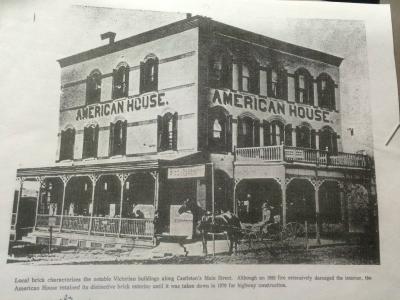
Knickerbocker News photo (by Bob Paley) about impending razing of buildings along North Main Street. Text below image reads: Awaiting the Wrecker? This quiet block of Main Street in the Village of Castleton may undergo a radical change within a year. The State Transportation Department is currently studying plans to demolish all 20 buildings on the west side of the street (left in this picture) to make room for the widening of Route 9J. The tentative state plan, which will be presented at a public hearing in the Village Hall on Jan. 15, calls for removal for all buildings from Scott Avenue (Route 150) north to the village line. The photograph was taken from the intersection of Main Street and Scott Avenue looking north.
The new railroad building opened in 1897, a beautiful two and a half story building which soon housed the telephone company and a new Van Hoesen store at the front. The railroad station is still extant today, albeit much altered. The new hotel across the way became the American House in 1897 (corner of Main Street and Scott Ave), demolished in 1970 along with the rest of the structures to the north along the west side of Main Street including the “Brick Row” [In 1872 George Schlemmer built the brick row known as the Griffith Block, a line of brick town houses on North Main Street, razed in 1970 when 9J was widened.] The text below image reads: The new railroad station in 1897.
American Hotel built of brick in Victorian style on a northerly dock, the latter survived a fire in 1889 but was razed in 1970 for highway construction (the widening of Route 9J). Test under image reads: Local brick characterizes the notable Victorian buildings along Castleton’s Main Street. Although an 1889 fire extensively damaged the interior, the American House retained its distinctive brick exterior until it was taken down in 1970 for highway construction.
Today, Castleton-on-Hudson is poised to make the most of its assets: a stunning Hudson River location only ten miles south of Albany and one mile north of the Schodack Island State Park; charming streets lined with Craftsman-style bungalows; a vital community of residents always ready to volunteer. In its adaptability, Castleton-on-Hudson today offers to both newcomers and long time residents a continuing small town atmosphere, and a appreciation of its history. Many small businesses boast historical photos of the town. People are proud of the village's place in the rich history of the Hudson Valley, and excited about the great things that are coming to the Village in the near furure.
"Like" the Village of Castleton-on-Hudson Facebook page!
Note: The above information relating to the history of Castleton-on-Hudson is based in part on the "Castleton History" prepared by Rev. Edward Ton, and on materials provided by area residents Alice P. Walsh and Shirley Dunn and Village Historian Ellen S. Allen. Dr. Gina Giuliano edited and updated it in 2016-17.
